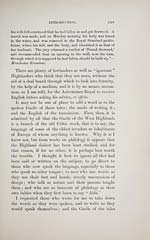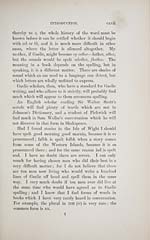Download files
Complete book:
Individual page:
Thumbnail gallery: Grid view | List view

CXvi INTRODUCTION.
is the result of such a process. The names of the
writers are given, and I am satisfied that they have
done their work faithfully and well. The Gaelic then
is not what is called " classical Gaelic." It is generally
the Gaelic of the people — pure from the source.
Next, as to orthography. I chose one man, ]\Ir.
Hector MacLean, whom I know to be free from prejudice,
and who knows the rules of Gaelic spelling, to correct
the press, and I asked him to spell the sounds which
he heard, according to the principles of Gaelic ortho-
graphy, whenever he wrote anything down himself ; and
in correcting the press for the work of others, to cor-
rect nothing but manifest mistakes, and this he has
done, as it appears to me, very well.
In Gaelic there are certain vowels, and combinations
of them, which represent certain sounds ; and they are
all sourided, and always in the same manner, according
to theory, but in practice it is a very different matter.
In speaking Gaelic, as is the case in other lan-
guages, varioixs modes of pronouncing the same vowels
exist in various districts. The consonants meet and
contend and extinguish each other, and change the
sound of the vowels in Gaelic more than in any other
language which I know ; but they fight by rule, and
the conquered and the slain encumber the words which
are their battlefields, as dead or dying consonants stand-
ing beside the silent li which kills or controls them.
One difficulty in writing Gaelic from dictation is to
ascertain, in words of doubtful meaning, whether the
sound V is to be expressed by hli or mh. The first
letter was once at the head of a small regiment of let-
ters, and sounded his own note in or h, and so he
regulated the meaning of the rest, but having fallen
in with an lb in an oblique case, and being changed
is the result of such a process. The names of the
writers are given, and I am satisfied that they have
done their work faithfully and well. The Gaelic then
is not what is called " classical Gaelic." It is generally
the Gaelic of the people — pure from the source.
Next, as to orthography. I chose one man, ]\Ir.
Hector MacLean, whom I know to be free from prejudice,
and who knows the rules of Gaelic spelling, to correct
the press, and I asked him to spell the sounds which
he heard, according to the principles of Gaelic ortho-
graphy, whenever he wrote anything down himself ; and
in correcting the press for the work of others, to cor-
rect nothing but manifest mistakes, and this he has
done, as it appears to me, very well.
In Gaelic there are certain vowels, and combinations
of them, which represent certain sounds ; and they are
all sourided, and always in the same manner, according
to theory, but in practice it is a very different matter.
In speaking Gaelic, as is the case in other lan-
guages, varioixs modes of pronouncing the same vowels
exist in various districts. The consonants meet and
contend and extinguish each other, and change the
sound of the vowels in Gaelic more than in any other
language which I know ; but they fight by rule, and
the conquered and the slain encumber the words which
are their battlefields, as dead or dying consonants stand-
ing beside the silent li which kills or controls them.
One difficulty in writing Gaelic from dictation is to
ascertain, in words of doubtful meaning, whether the
sound V is to be expressed by hli or mh. The first
letter was once at the head of a small regiment of let-
ters, and sounded his own note in or h, and so he
regulated the meaning of the rest, but having fallen
in with an lb in an oblique case, and being changed
Set display mode to: Large image | Transcription
Images and transcriptions on this page, including medium image downloads, may be used under the Creative Commons Attribution 4.0 International Licence unless otherwise stated. ![]()
| Early Gaelic Book Collections > Matheson Collection > Popular tales of the west Highlands > Volume 1 > (136) |
|---|
| Permanent URL | https://digital.nls.uk/81388860 |
|---|
| Description | Volume I. |
|---|---|
| Shelfmark | Mat.74 |
| Additional NLS resources: | |
| Attribution and copyright: |
|
| Description | Items from a collection of 170 volumes relating to Gaelic matters. Mainly philological works in the Celtic and some non-Celtic languages. Some books extensively annotated by Angus Matheson, the first Professor of Celtic at Glasgow University. |
|---|
| Description | Selected items from five 'Special and Named Printed Collections'. Includes books in Gaelic and other Celtic languages, works about the Gaels, their languages, literature, culture and history. |
|---|

